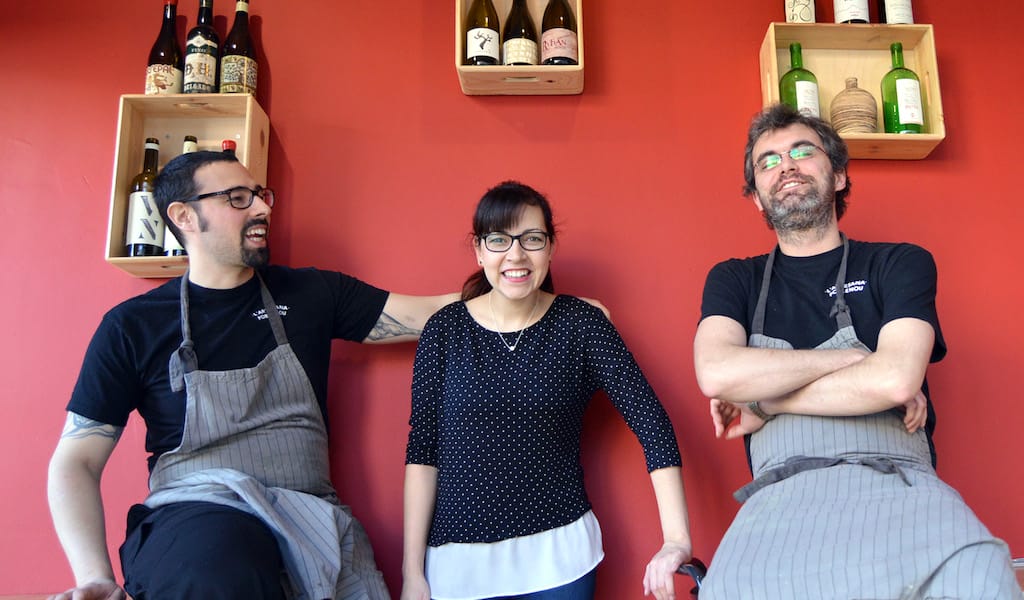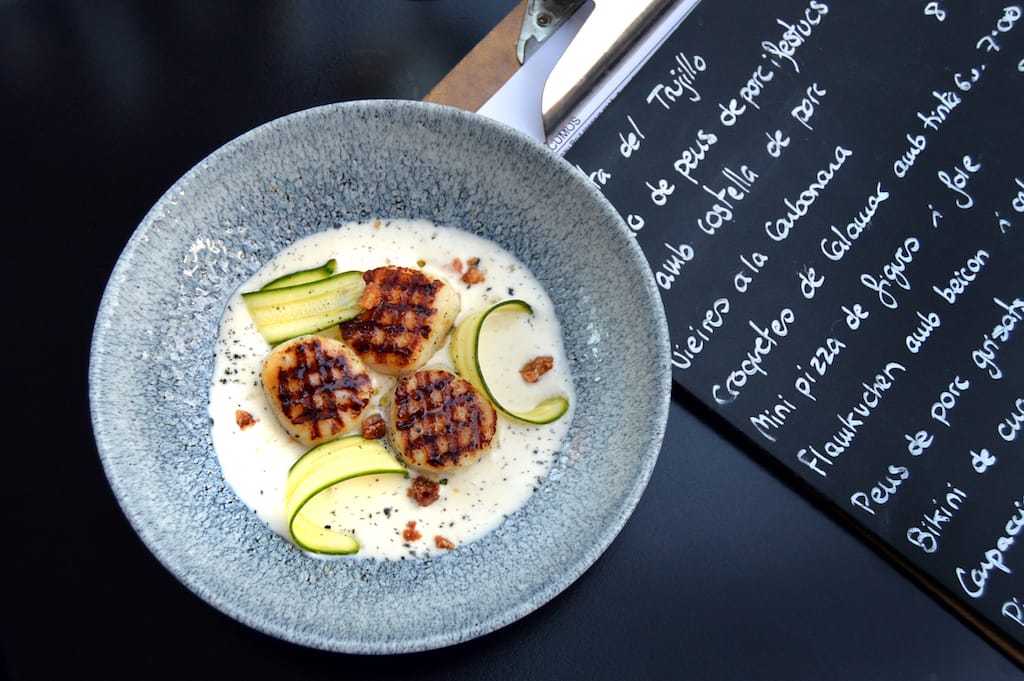Years ago, when it was a booming industrial center, Poblenou saw thousands of workers stream in every day to toil away at one of several factories in the neighborhood. Hearty fare was required to keep them going – sure, taste mattered, but sustenance was the most pressing concern.
Poblenou may no longer be filled with factories, but there are still plenty of people who spend their weekdays in the area, working at one of the many start-ups, tech companies or communications firms that have set up shop in their place. When it comes to lunch, these 21st-century workers want the same thing that those who came before them did: lunches that fill their stomachs and satisfy their taste buds without leaving a big hole in their pockets. Fortunately for them, the neighborhood is now home to L’Artesana.
Even though it’s only been in operation for a few months, L’Artesana is already one of the most interesting restaurants in a new wave of culinary projects that are setting their sights outside of the city center. Named after an old local worker cooperative, L’Artesana cooks for the neighborhood, taking great care to pay homage its traditional roots while incorporating a contemporary style.
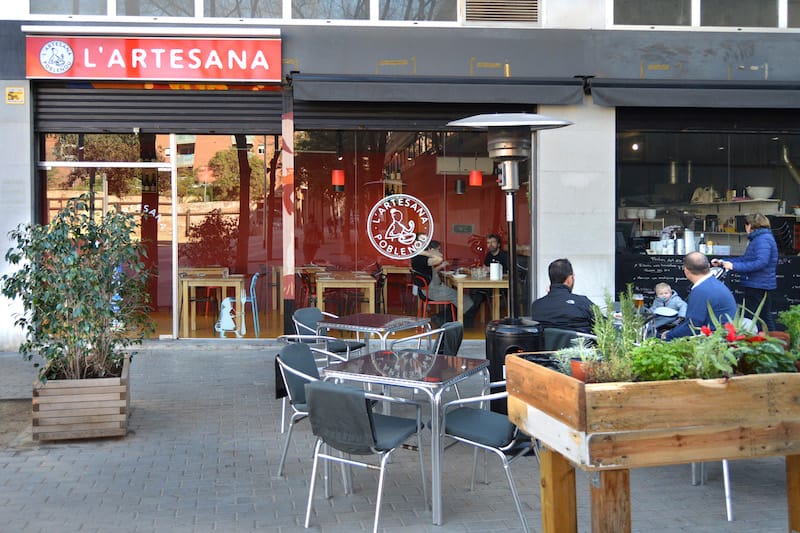
The restaurant is the creation of three partners: Romina Reyes, the restaurant’s front of the house manager and sommelier, and the two head chefs, Héctor Barbero and Pau Pons. They first met eleven years ago, in the Michelin-starred restaurant Mas Pau, at that time located in Figueres, a town northeast of Barcelona, and then found each other again, after different experiences in a number of great restaurants, in the excellent Gresca, after which they moved together to the wine bar Monvinic, where Sergi de Meiá was head chef at the time. After splitting up again, they decided to take the plunge and open up L’Artesana. “Even at Mas Pau we were always talking about creating something together,” says Héctor. “We finally decided that it was the right time.”
As for where to open the restaurant, they opted for Hector’s home turf, Poblenou. “I always had Poblenou in mind, not just because it’s my neighborhood but because it doesn’t have a restaurant like ours, where people can come to have fun and eat something special at a very reasonable price,” Héctor says.
So that’s exactly what they created. Using their technical expertise, developed over the years in all those other restaurants, Héctor and Pau spotlight the ingredients, usually local and, when possible, organic. Their light, simple creations are based in tradition but have a modern twist. The wine list, selected by Romina, features around 50 options from small producers, with a strong preference given to organic, biodynamic or even natural wine. And, to top it off, the prices are worker-friendly.
“I always had Poblenou in mind, not just because it’s my neighborhood but because it doesn’t have a restaurant like ours.”
From Monday to Friday, L’Artesana starts the day right, offering a wonderful “spoon” breakfast, the name given to hearty Catalan breakfasts, generally stews, that must be eaten with a spoon. Our favorite is the traditional callos, a spicy stew made with tripe. They also serve the more contemporary eggs Benedict, which is not easy to find in Poblenou, and delicious sandwiches that feature interesting seasonal ingredients, like calçots or marinated salmon, as well as the more traditional options of ham and cured sausages.
On weekdays, they have both a selection of tapas and a daily menu (menú del día); the latter is immensely popular. For €12.50, you can choose one of three starters (and there’s always a vegetarian option), then either the daily special (plato del día) or a meat or fish dish for the main meal, and, to finish, one of two dessert options. The daily specials are the same every week: rigatoni on Monday, noodles on Tuesday, gnocchi on Wednesday, rice (paellas and similar dishes) on Thursday and fricandó, traditional Catalan beef stew with mushrooms, on Friday.
On a recent Tuesday, we opted for the daily menu. The starter was a delicious cauliflower salad with spinach leaves, crushed hazelnuts and aromatic herbs – a healthy way to kick off the meal that had the added bonus of contrasting sensations, soft and crunchy, juicy and dry. Then came the daily special: thick noodles with artichokes and butifarra (fresh Catalan pork sausage) in a bit of succulent sauce.

But more often than not, we splash out for the tasting menu, which includes four of the dishes from the daily menu, presented in smaller portions, and one of two desserts for the surprisingly reasonable price of €18.50 – we can’t think of a more affordable way to get high-quality cuisine on your lunch break.
The tasting menu we had last week featured four outstanding courses, the first being a Caesar salad that didn’t shy away from using salted anchovies, which added a refreshing kick to the dish. This was followed by a tiny coca, a thin pastry covered with calçots, Catalonia’s iconic salsa romesco and small pieces of meaty marinated anchovies, an intense but delicious bite. Next up was a succulent small trinxat – the extremely smooth cabbage and potato mash was wrapped in a thin layer of delicate and creamy pork jowl. The main dish was a small portion of boned pork cheek cooked at a low temperature that was fork-tender, buttery in the mouth and served with mashed potatoes and a sauce made from the meat reduction. The house wine was a full-bodied, well-rounded and very fruity organic wine from the bulk wine collection Organic & Orgasmic by La Festival, created by Rubén Parera with 50 percent Grenache and lower percentages of Merlot and Cabernet Sauvignon.
The weekends, when everyone’s off work, are when the most fun happens – the customers who visit are here purely for pleasure. According to Hector and Pau, they can be more creative in the kitchen, as they’re not beholden to the regular daily specials. As a result, their weekend à la carte menu features ever-changing small plates made with higher quality ingredients, often organic, but still at affordable prices. In addition to these rotating plates, the menu also has a number of classic mainstays that are always available, like the potato rösti and pork jowl with razor clams in teriyaki sauce.
Even so, L’Artesana is first and foremost a spot for people to drop in before or during work, providing just what the neighborhood’s workers want and deserve.
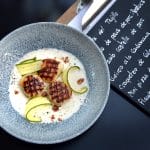 January 17, 2020 TocaTeca: Gastronomic Unicorn
January 17, 2020 TocaTeca: Gastronomic Unicorn
A former village annexed to Barcelona in 1897, the city’s Sant Andreu district was a […] Posted in Barcelona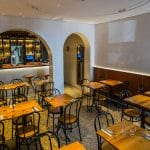 March 29, 2019 Cacué
March 29, 2019 Cacué
José Saudade e Silva always knew, deep down, that he wasn’t cut out for tedious office […] Posted in Lisbon February 11, 2019 Restaurante Leka
February 11, 2019 Restaurante Leka
VCompared to many of the contemporary restaurants and bars in Poblenou’s 22@ district, a […] Posted in Barcelona
Published on February 15, 2018
Related stories
January 17, 2020
BarcelonaA former village annexed to Barcelona in 1897, the city’s Sant Andreu district was a center of industrial development throughout the 20th century, becoming home to a large population of factory workers. Today, it is a quiet residential area that feels caught between its Catalan village roots and industrial past, with buildings being renovated and…
March 29, 2019
LisbonJosé Saudade e Silva always knew, deep down, that he wasn’t cut out for tedious office life. So one day in 2014, after studying marketing and working a 9-to-5 job in that same field, he bought a one-way ticket to Oslo, where he had some friends. He didn’t exactly know how he would make a…
February 11, 2019
BarcelonaVCompared to many of the contemporary restaurants and bars in Poblenou’s 22@ district, a hub for tech companies and start-ups in Barcelona, Restaurante Leka has relatively deep roots: it first opened as a traditional truck driver’s inn and eatery in 1984. But don’t let its history fool you – this is a spot committed to…







































